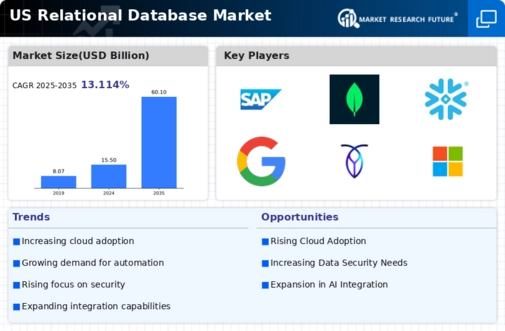Expansion of Big Data Technologies
The intersection of big data technologies and relational databases is creating new opportunities. As organizations generate vast amounts of data, the need for scalable and efficient database solutions is paramount. Relational databases are evolving to accommodate big data workloads, enabling businesses to harness the power of large datasets for analytics and insights. The big data market is projected to reach $274 billion by 2022, and a significant portion of this growth is likely to be supported by advancements in relational database technologies. This evolution suggests a promising future for the relational database market as it adapts to the demands of big data.
Shift Towards Hybrid Cloud Environments
The relational database market is witnessing a shift towards hybrid cloud environments as organizations seek to balance flexibility and control over their data. This trend is driven by the desire to leverage the benefits of both on-premises and cloud-based solutions. Hybrid cloud architectures allow businesses to optimize their database deployments, ensuring scalability while maintaining data security. It is estimated that the hybrid cloud market will grow to $97 billion by 2025, with relational databases playing a crucial role in this transformation. This shift indicates a growing recognition of the relational database market's adaptability to evolving IT infrastructures.
Rising Need for Data Integration Solutions
As businesses continue to expand their digital footprints, the need for effective data integration solutions is becoming increasingly critical. The relational database market is responding to this demand by offering enhanced capabilities for integrating disparate data sources. Organizations are seeking to unify their data environments to improve analytics and reporting. It is estimated that the data integration market will reach $10 billion by 2026, with a significant portion of this growth attributed to relational database technologies. This trend indicates a shift towards more cohesive data management strategies, essential for leveraging the full potential of data assets.
Growing Demand for Real-Time Data Processing
The relational database market is experiencing a notable surge in demand for real-time data processing capabilities. Organizations are increasingly relying on instantaneous data access to enhance decision-making and operational efficiency. This trend is particularly evident in sectors such as finance and e-commerce, where timely data insights can lead to competitive advantages. According to recent estimates, the market for real-time data processing solutions is projected to grow at a CAGR of approximately 25% over the next five years. This growth is likely to drive investments in relational database technologies that support real-time analytics, thereby shaping the future landscape of the relational database market.
Increased Regulatory Compliance Requirements
The growing landscape of regulatory compliance requirements influences the relational database market. Organizations are facing heightened scrutiny regarding data governance, privacy, and security. Regulations such as the CCPA and GDPR necessitate robust data management practices, compelling businesses to adopt relational database solutions that ensure compliance. This shift is likely to drive the adoption of advanced features such as data encryption and access controls in relational databases. As compliance becomes a priority, the relational database market is expected to see a rise in demand for solutions that facilitate adherence to these regulations, potentially increasing market growth by 15% over the next few years.

















Leave a Comment